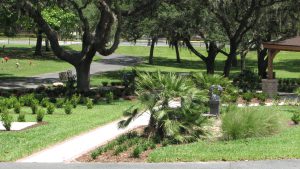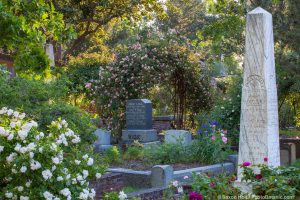Halloween is a festive occasion for the ghoul and goblin enthusiasts. However, let’s not leave the gardener’s out of the fun. Have you ever noticed the trees and shrubs in the cemeteries? Of course, some cemeteries stand out more than others. This is known as ‘Cemetery Horticulture’. Let’s take a look at some of the plants you will find in cemeteries around the world. You will be surprised that many of them have special meanings.
Plant Selections
- Acacia: Symbolizes rebirth ad everlasting life.

Palms and Oaks used in attractive cemetery landscape.
Photo Credit: Memorial Planning - Bamboo: Chinese cultures view this plant as hope against scaring off evil spirits and demons when on fire. It also is an amulet for good luck.
- Cedar & Yew: These both symbolize eternal life.
- Chrysanthemum: Japanese cultures see this plant as the sun. It brings immortality, and the eternal life of the Imperial Family. Europeans associate this flower with harvest.
- Holly: In historic times, people believed that it served to ward off tombstones from lightning strikes.
- Ivy: Many early Americans planted ivy to represent friendship and immortality.
- Myrtle: This tree represents achievement and indicates eternal life.
- Oak: The leaves of this tree represent power, victory, or authority which is why you will see many in military cemeteries.
- Pine: The seed in the cones are said to bring perpetuity of life and renewal. It also represents immortality.

‘Souv de Mme Leonie Viennot’, old rose on trellis in Sacramento Old City Cemetery; ‘Marie’ Pavie’ white rose - Rose: These shrubs are to signify completion and the achievement of perfection and beauty.
- Thistle: In Scotland, men carve this in their headstones, representing their nationality and their international dispersal of the weed.
- Willow: Sadness or mourning. In Native American cultures, a willow tree represents an Iroquois grave.
- Century Plant: Represents immortality; everlasting life.
- Dogwood: symbolizes resurrection, sacrifice, and eternal life.
- Palm Tree: Victory over death.
The next time you find yourself in cemeteries, glance around at the diversity of plant selections between regions. Be mindful of their meaning and their historic significance. For further information: http://connections.smsd.org .
 2
2


